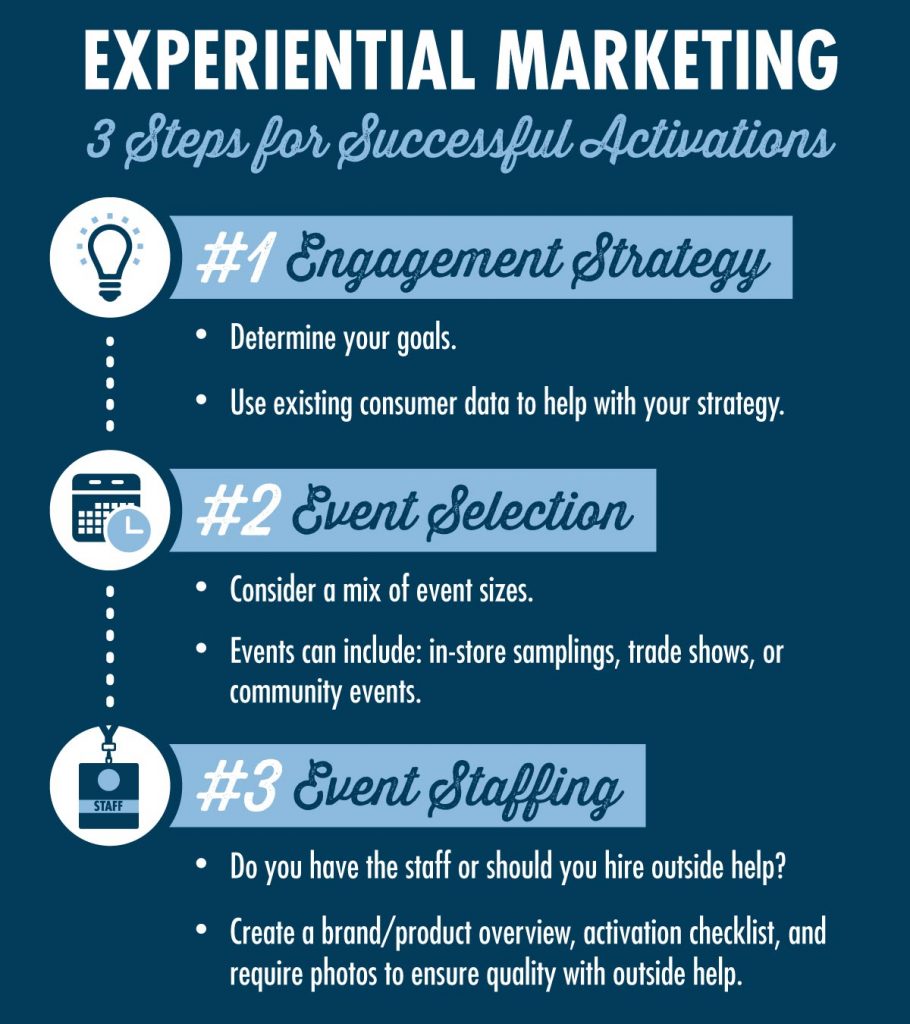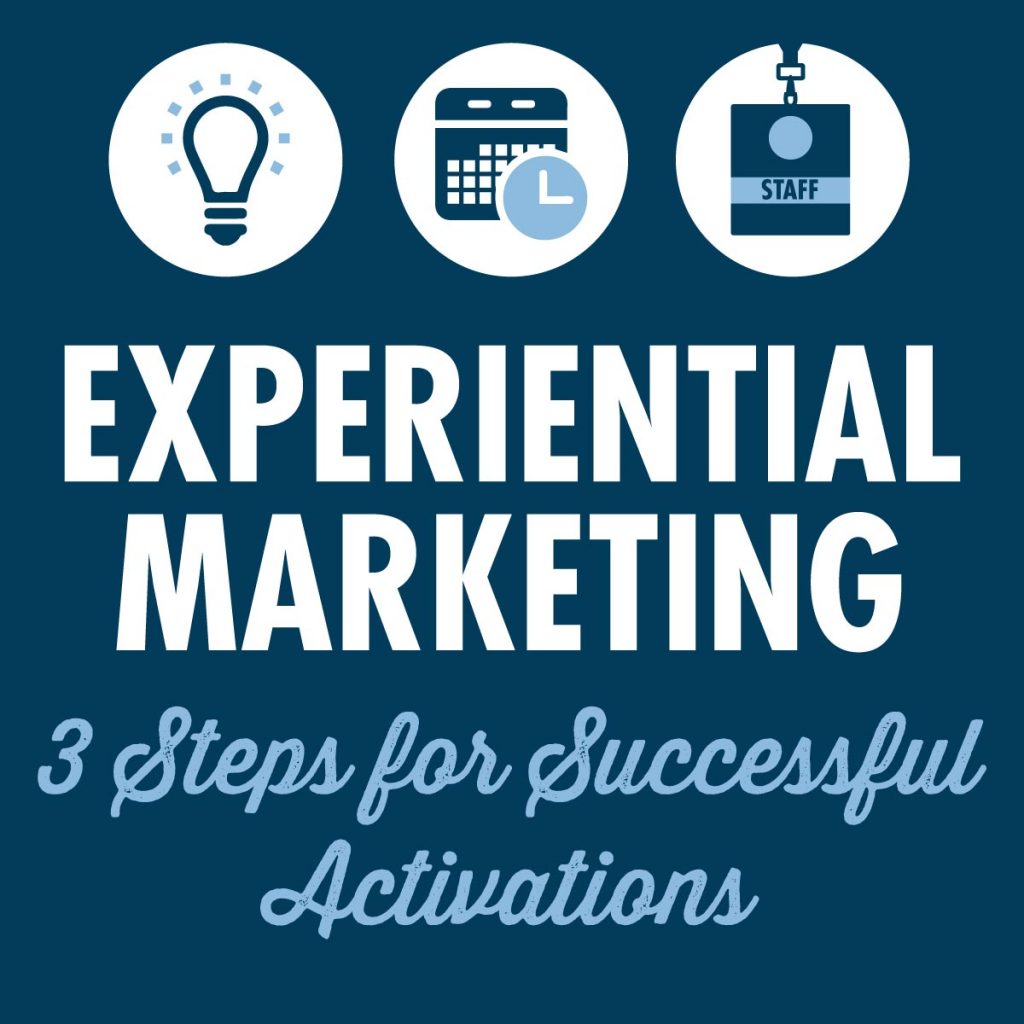When was the last time you bought a product for the first time? Perhaps you saw an ad on television or online, or possibly it was the packaging that caught your eye. Chances are there was a moment of doubt about whether you would like that product prior to purchasing. This doubt of uncertainty can give consumers pause and cause your brand to lose out on the sale. That’s why most brands can’t rely solely on flashy T.V. ads or eye catching billboards. While online reviews play an important role in today’s decision making process, consumers often want to be able to touch, feel or experience a product or service prior to the financial transaction.
Experiential marketing allows brands the opportunity to engage with consumers on a one-on-one level. It gives buyers a chance to hold, taste or see a product in action. These experiences resonate with consumers, and, if done correctly, can provide a measurable return on your investment.
To help you get started, here are three areas to help refine your experiential marketing strategy.
#1 – Engagement Strategy
Throughout the entire experiential marketing planning process, you should always be thinking about the way you want to engage potential consumers. This will factor into your event selection, staffing and activation setup. While each brand is unique, we have found several successful tactics with our clients, including interactive games, product sampling, promotional giveaways, and enter-to-win data capture opportunities. Always have goals determined on the front-end and ways you plan to measure success.
Promotional materials might include product literature, coupons, or even ‘swag’ items such as t-shirts, coasters and key chains. No matter what you hand out, we always recommend that you stock more than you think you’ll need. The last thing you want is to run out of product before the end of the event.
We also recommend you implement a procedure for capturing data. This can be accomplished via giveaways, raffle prize drawings or coupons. Not only will this engage consumers, it will also allow you to gather first-party data that can then be used to remarket interested consumers after the event.
Finally, experiential marketing allows consumers to provide immediate feedback about your brand. This feedback should be analyzed for trends to help you improve product design, brand positioning, or key messaging at future events.
#2 – Event Selection
Once your engagement strategy is determined, the next step in developing your experiential marketing strategy is to consider location. Where do you prefer consumers engage with your product or service? Opportunities might include in-store sampling, consumer trade shows, or community events. Many times a brand has limited funds to invest in their marketing. Therefore, we like to take the “fish where the fish are” approach. For the purposes of this post, we’re going to focus on events.
When scheduling, look for reputable opportunities that target your core consumer demographic. While there is no magic number of activations to execute, we recommend considering a mix of of event sizes. For example, say you are selling a new sports drink and have determined your core user demo to be active males between the ages of 15-35. Planning a large, experiential activation, such as a professional sporting event, allows your brand to gain exposure in front of a large number of consumers who fall into this demographic. It can also provide your brand instant credibility in the within your consumer segment.
At the same time, participating in a smaller event, allows you to be hands on with potential consumers in a more intimate environment. The combination of the two will resonate with consumers and help you stay top-of-mind over your competitors.
#3 – Event Staffing
In a perfect world, brands would have their own employees staff each activation, as they know more about the product/service than anyone else. However, this can be challenging on both schedule and budget. If a brand has several events over a short span of time, it can be costly to bring your team to every event. For these situations, we recommend a brand hire an agency to staff each activation with brand ambassadors. Many times, it can be uncomfortable to put your trust in an outside group, particularly since this might be the first impression your brand makes in that market. For our clients, we make sure to create a brand/product overview, activation checklist, and require photos be taken throughout the activation to ensure quality and accountability.
The number of staff or ambassadors can vary based on your brand and event. We recommend overstaffing. You’re investing significant budget for the event and giveaways, so it’s wise to ensure you’re covered when it comes to consumer engagement, data capture, giveaways, etc.
A Holistic Approach
Advertising and social media have a powerful influence over the products we are exposed to, but old fashioned word-of-mouth is still strong. One of the best ways to leave your brand’s imprint on a consumer is through an experiential activation. Brands build credibility by providing continually exceptional service, which is propelled by obtaining great feedback. Experiential marketing allows brand enthusiasts to share their experiences on your brand’s behalf.
Let us know if you have an idea you’d like to kick around. We would love to help you plan and execute your next experiential marketing campaign.

